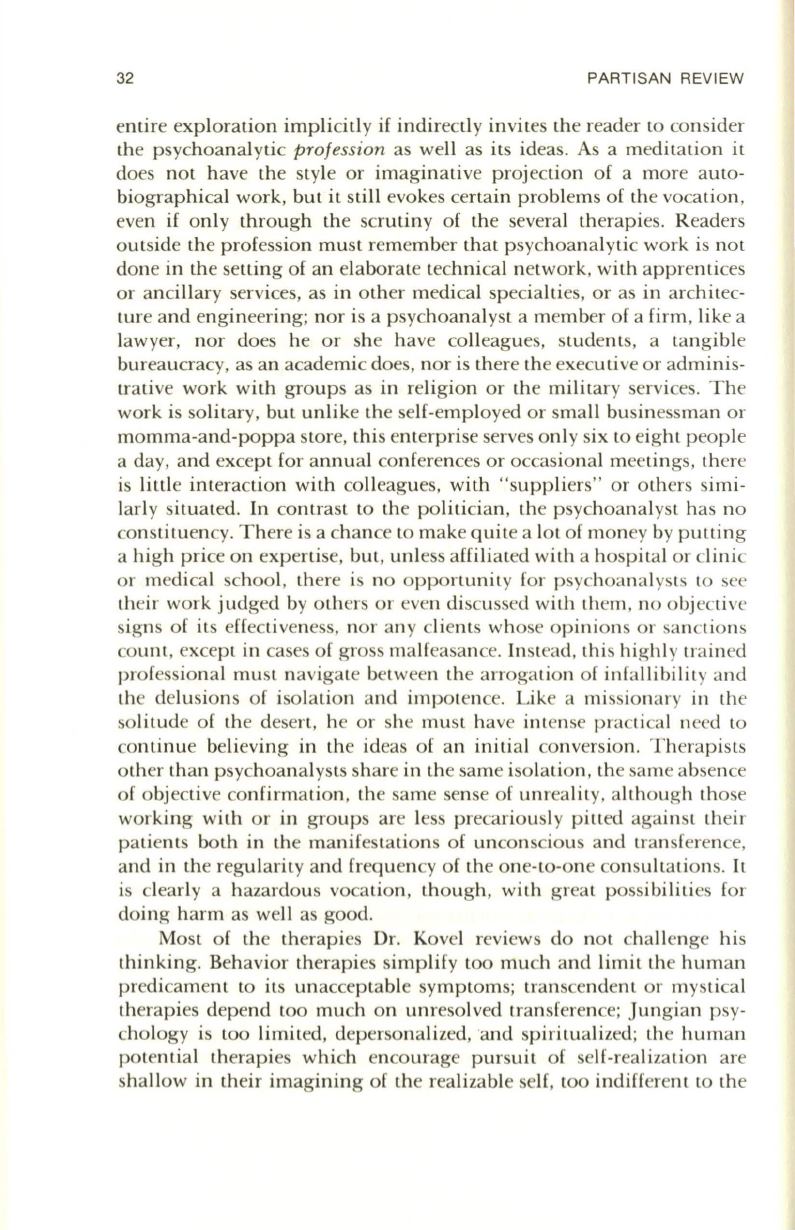
32
PARTISAN REVIEW
entire exploration implicitly if indirectly invites the reader to consider
the psychoanalytic
profession
as well as its ideas. As a med itation it
does not have the style or imaginative proj ection of a more auto–
biographical work, but it still evokes certain problems of the vocation,
even if only through the scrutiny of the several therapies. Readers
outside the profession must remember that psychoanalytic work is not
done in the setting of an elaborate technical network, with apprentices
or ancillary services, as in other medical specialties, or as in architec–
ture and engineering; nor is a psychoanalyst a member of a firm , like a
lawyer, nor does he or she have colleagues, students, a tangible
bureaucracy, as an academic does, nor is there the executive or adminis–
trative work with groups as in religion or the military services. The
work is solitary, but unlike the self-employed or small businessman or
momma-and-poppa store, this enterprise serves only six to eight people
a day, and except for annual conferences or occasional meetings, there
is little interaction with colleagues, with "suppliers" or others simi–
larly situated. In contrast to the politician, the psychoanalyst has no
constituency. There is a chance to make quite a lot of money by putting
a high price on expertise, but, unless affiliated with a hospital or clinic
or medical school, there is no opportunity for psychoanalysts to see
their work judged by others or even discussed with them, no objective
signs of its effectiveness, nor any clients whose opinions o r sanctions
count, except in cases of gross malfeasance. Instead, this hi ghl y trained
professional must nav igate between the arrogation of infallibility and
the delusions of isolation and impotence. Like a missionary in the
solitude of the desert, he or she must have intense practical need to
continue believing in the ideas of an initial conversion. Therapists
other than psychoanalysts share in the same isolation , the same absence
of objective confirmation, the same sense of unrea lity, although those
working with or in groups are less precariously pitted against their
patients both in the manifes ta tions of unconscious and transference,
and in the regularity and frequency of the one-to-one consultations.
It
is clearly a hazardous vocation, though, with great possibilities for
doing harm as well as good.
Most of the therapies Dr. Kovel reviews do not chall enge his
thinking. Behavior therapies simplify too much and limit the human
predicament to its unacceptable symptoms; transcendent or mystical
therapies depend too much on unresolved transference; Jungian psy–
chology is too limited, depersonalized, and spiritualized; the human
potential therapies which encourage pursuit of self-realization are
shallow in their imagining of the realizable self, too indifferent to the


